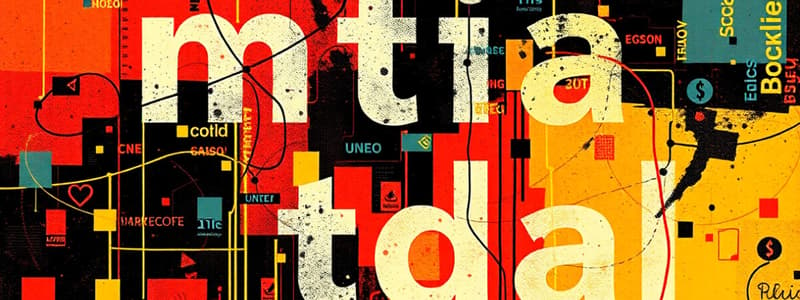Podcast
Questions and Answers
What is the purpose of media?
What is the purpose of media?
To collect, transfer and synthesize information for the purpose of dissemination.
What are some characteristics of people who are considered 'tech savvy'?
What are some characteristics of people who are considered 'tech savvy'?
They have the skill and knowledge to operate modern technology devices effectively.
Which of the following is NOT a characteristic of text media?
Which of the following is NOT a characteristic of text media?
- Provides time for consideration
- Literary critic
- Accessible in multiple formats
- Easy recognizable
- Not customizable (correct)
Contrast in design elements refers to the positioning of elements on the medium.
Contrast in design elements refers to the positioning of elements on the medium.
What is the primary advantage of visual media?
What is the primary advantage of visual media?
What is the purpose of testing in the context of programming?
What is the purpose of testing in the context of programming?
Which type of test involves using the interface and user interaction?
Which type of test involves using the interface and user interaction?
What does 'analog' refer to in the context of audio media?
What does 'analog' refer to in the context of audio media?
Motion media is a type of visual that represents movements, but doesn't simulate them.
Motion media is a type of visual that represents movements, but doesn't simulate them.
Manipulative media are tools used for teaching that engage students visually but not physically.
Manipulative media are tools used for teaching that engage students visually but not physically.
What is an advantage of traditional manipulative media?
What is an advantage of traditional manipulative media?
What is the primary advantage of virtual and digital manipulative media?
What is the primary advantage of virtual and digital manipulative media?
Flashcards
People
People
Groups of individuals that can collect, store, and analyze information.
Media
Media
Channels or means used to collect, transfer, and synthesize information for a specific purpose.
People in Media
People in Media
Experts who use media to disseminate information. They are often considered authoritative sources on topics.
People as Media
People as Media
Signup and view all the flashcards
Tech Savvy
Tech Savvy
Signup and view all the flashcards
Credible
Credible
Signup and view all the flashcards
Flexible
Flexible
Signup and view all the flashcards
Charismatic
Charismatic
Signup and view all the flashcards
Updated
Updated
Signup and view all the flashcards
Articulate
Articulate
Signup and view all the flashcards
Bugs
Bugs
Signup and view all the flashcards
Debugging
Debugging
Signup and view all the flashcards
Text
Text
Signup and view all the flashcards
Text Media
Text Media
Signup and view all the flashcards
Accessible in multiple formats
Accessible in multiple formats
Signup and view all the flashcards
Easy Recognizable
Easy Recognizable
Signup and view all the flashcards
Provides Time for Consideration
Provides Time for Consideration
Signup and view all the flashcards
Customizable
Customizable
Signup and view all the flashcards
Literary Critic
Literary Critic
Signup and view all the flashcards
Emphasis
Emphasis
Signup and view all the flashcards
Contrast
Contrast
Signup and view all the flashcards
Organization
Organization
Signup and view all the flashcards
Repetition
Repetition
Signup and view all the flashcards
Alignment
Alignment
Signup and view all the flashcards
Proximity
Proximity
Signup and view all the flashcards
Visual Media
Visual Media
Signup and view all the flashcards
Minimize Text
Minimize Text
Signup and view all the flashcards
Delivers the Message Quickly
Delivers the Message Quickly
Signup and view all the flashcards
Highly Customizable and Varied
Highly Customizable and Varied
Signup and view all the flashcards
Easily Updated
Easily Updated
Signup and view all the flashcards
Accessible and Recognizable
Accessible and Recognizable
Signup and view all the flashcards
Testing
Testing
Signup and view all the flashcards
White Box Testing
White Box Testing
Signup and view all the flashcards
Study Notes
Media and People
- Media are channels used to collect, transfer, and synthesize information.
- Experts share information through media channels.
- People can act as media, transferring information directly to others.
- People who act as media should be technologically skilled, credible, flexible, charismatic, updated, and articulate.
Text Media
- Text media uses symbols for information exchange.
- Text media is accessible in multiple formats.
- Text media is easily recognizable.
- Text media provides time for consideration before understanding.
- Text media is customizable.
- Text media requires literacy for understanding the meaning.
Media Advantages and Disadvantages
- Media design emphasizes specific information.
- Media design creates a cohesive structure.
- Media use repetition, alignment, and proximity for organization in design.
- Visual media (images, pictures) rely on the user's ability to see to deliver a message quickly.
- Visual media uses minimal text and avoids large amounts of reading.
- Visual media is highly customizable and easily updated.
- Visual media is accessible and recognizable.
Design Elements and Principles
- Design principles involve using lines, shapes, values, textures, and colors.
- Principles include repetition, a center of interest, balance, harmony, contrast, directional movement, rhythm, and perspective.
- These principles are used in creating a strong visual impact.
- Design elements and principles enhance the impact of media.
- Testing is used in software or media to find errors.
- Test types exist, including white box tests that check the code's instructions and black box tests utilizing user interaction.
- Testing ensures high-quality media.
Audio Media
- Audio media uses sound to communicate.
- Audio media includes dialogue, sound effects, music, and silence (silence as an element).
- Mixing, pace, and transitions are important in creating audio effects.
Motion Media and Visuals
- Motion media demonstrates movement visually.
- Design elements include speed, direction, motion, and object timing.
- Design principles establish principles for creating motion media.
Manipulative Media
- Traditional media includes tangible objects.
- Students gain confidence and collaboration through their use.
- Virtual manipulative media is increasingly available.
- This type of media offers engaging, flexible, and no cleanup-needed resources.
Studying That Suits You
Use AI to generate personalized quizzes and flashcards to suit your learning preferences.




